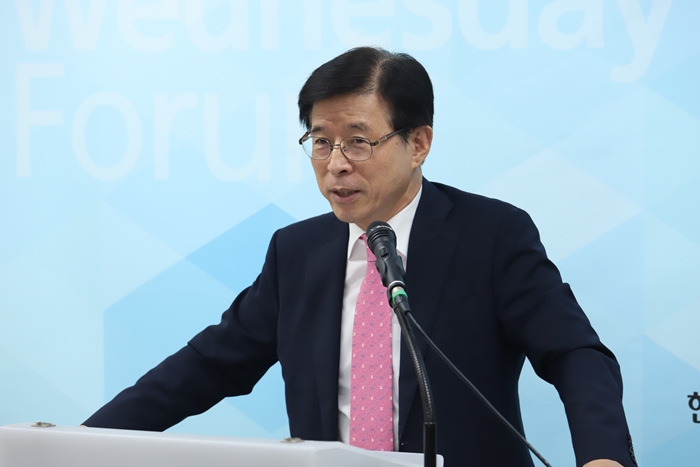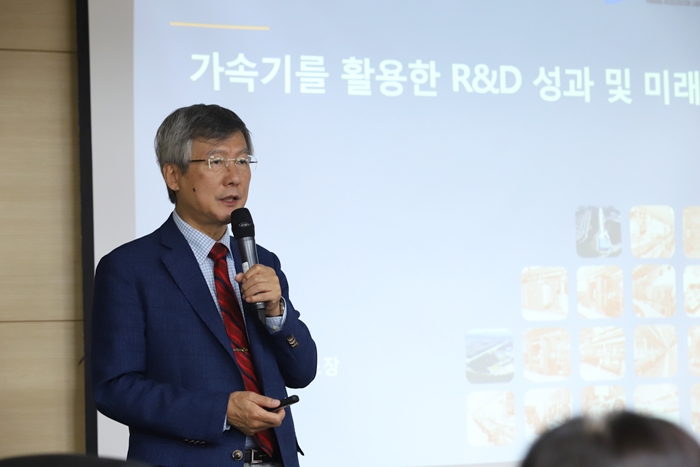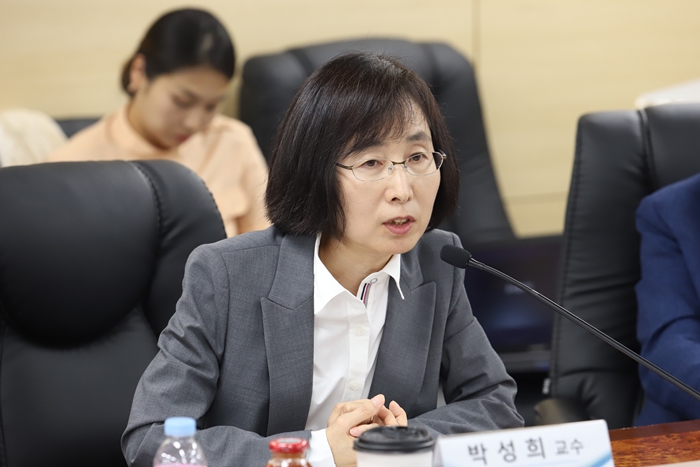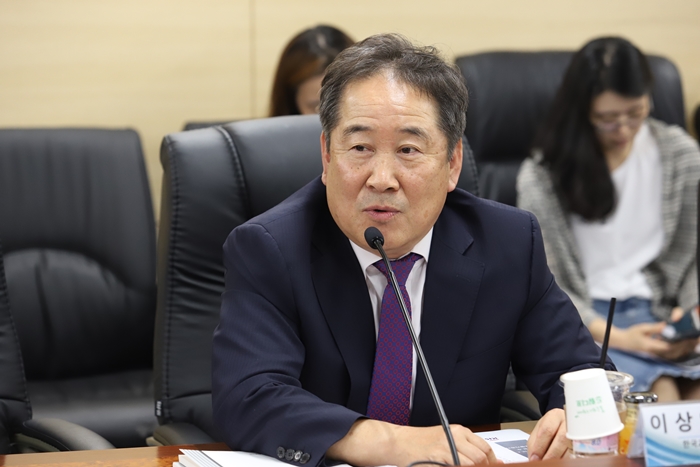News & Event


News & Event
News & Event
[The 112th KISTEP Wednesday Forum] Performance Status and Future of R&D Utilizing Accelerator
- Writer Yeory Lim
- Date2019-10-04
- Hit966
File
-
Download
 20191004084131.jpg
(159.15KB / Download 205회)
20191004084131.jpg
(159.15KB / Download 205회)
KISTEP held the 112th Wednesday Forum with the theme of ‘Performance Status and Future of R&D Utilizing Accelerator’ on October 2nd (Wed), 2019.
Accelerators were mainly used for basic science researches in nuclear physics and particle physics. Recently its application is getting expanded to nano-, bio-, and energy-related areas, it is utilized in various ways such as creating rare isotopes, developing new matters and materials, and curing cancers. Korea developed the Pohang Light Source (PLS) in Pohang, the proton accelerator in Gyeongju, and the heavy ion accelerator in Daejeon with the long-term R&D investment, on the other hand, keeps investing in R&D to develop next-generation technologies of accelerators. In the mean time, due to the high sunk costs and huge management costs, it is necessary to consider revitalizing basic science through accelerators and making smooth industrial use. Therefore, this forum was prepared to share major scientific·technologic·social performances of the domestic accelerators in operation, and to seek policy alternatives for effective use and management of the accelerators.
Accelerators were mainly used for basic science researches in nuclear physics and particle physics. Recently its application is getting expanded to nano-, bio-, and energy-related areas, it is utilized in various ways such as creating rare isotopes, developing new matters and materials, and curing cancers. Korea developed the Pohang Light Source (PLS) in Pohang, the proton accelerator in Gyeongju, and the heavy ion accelerator in Daejeon with the long-term R&D investment, on the other hand, keeps investing in R&D to develop next-generation technologies of accelerators. In the mean time, due to the high sunk costs and huge management costs, it is necessary to consider revitalizing basic science through accelerators and making smooth industrial use. Therefore, this forum was prepared to share major scientific·technologic·social performances of the domestic accelerators in operation, and to seek policy alternatives for effective use and management of the accelerators.

▲ Sang-seon Kim (President, KISTEP)
The forum was began with the opening address of Sang-seon Kim (President, KISTEP) and followed by the presentations of In Soo Ko (Director, Pohang Accelerator Laboratory). Panel discussion was led by Seong Hee Park (Professor, Korea University) and Sang-Youb Lee (Senior researcher, Center for R&D Feasibility Anlaysis Ⅰ, KISTEP), and open floor discussion followed.

▲ In Soo Ko (Director, Pohang Accelerator Laboratory)
Director In Soo Ko firstly presented about the current status of Pohang Accelerator Laboratory (PAL) and Pohang Light Source (PLS) operating in the laboratory. With the explanation about the history and organization of PAL, business project system, and PLS-Ⅱ(3rd-generation Pohang light source), he mentioned that “PLS-Ⅱ was developed from PLS, first operated in September, 1995, after 3 years of performance enhancement, it can operate 35 beam-lines simultaneously because it consisted of complex liner and circular accelerators.” Then he added that “For experiments utilizing PLS-Ⅱ to contribute to enhance national competitiveness, PAL operates the industrial technology convergence center and supports small- and medium-sized businesses that have limited data analysis skills.” He introduced PLS-XFEL (4th-generation Pohang light source) and clarified that “PLS-XFEL has limited simultaneous operation of beam-lines because of its linear structure, however it has strength on researches of new materials, new medicine, and new renewable energy as real-time dynamic analysis (video) is possible. Moreover, he emphasized that PLS-XFEL showed tangible performances such as the research about molecular structure changes of water and the protein structure analysis of ‘Lamin.’
Next, during his presentation about the management performances of PLS, he explained technologic·economic performances such as technology transfers derived from the high efficiency of PLS, saying that “The number of experiments in 2012, 829, was almost doubled in 2018 to 1637, and it shows the scientific performance that the number of papers from those experiments is gradually increasing.”
Lastly, director Ko presented the concept and natures of next-generation 4GSR (4th-Generation Storage Ring). The next-generation 4GSR is an accelerator that improved brightness by about 100 times compared to existing 3rd-generation PLS, and it can observe much smaller microscopic world than the 3rd-generation PLS. For the reasons why this next-generation 4GSR is needed, he pointed that there are demands on areas that existing accelerators in operation cannot provide, and experimental demands is well above the time to use the accelerators. And he suggested principles to keep when developing next-generation 4GSR as ▲sharing all experience and knowledge required for designing 4GSR, ▲reflecting from principle designs that next-generation 4GSR and PLS-Ⅱ can operate complementary one another, ▲trying adventurous design but not too drastic, and ▲designing that the components of next-generation 4GSR and PLS-Ⅱ can be compatible.

▲ Seong Hee Park (Professor, Korea University)
In panel discussion, professor Seong Hee Park said that “While it is important to produce outcomes in industries and medical areas to change the perception that accelerators are the exclusive property of some scientists, researches that have to be done using accelerators can be overlooked if scientists too tied to producing outcomes.” and argued that it is necessary to push ahead with researches that do not produce tangible results immediately. Also she suggested that “It is good to develop new accelerators to keep up human resources related to existing accelerators built in late 1990s, but it is necessary to strategically plan·systematize human resources and researches related to accelerators.” Lastly, she mentioned that “The people who know about accelerators don’t know about beam-lines, and the people who know about beam-lines are not good at data analysis of accelerator experiments. In this circumstance, human resources who can bridge between them should be fostered.”

▲ Sang-Youb Lee (Senior researcher, Center for R&D Feasibility Anlaysis Ⅰ, KISTEP)
Senior researcher Sang-Youb Lee started saying that “There is a gab between the people who actually build accelerators and the people who look at it.” He suggested that criticism about accelerators should be reduced saying that “Although 3 months were expected to build up one QWR superconducting accelerator module at first, it took a year and half by tests and verifications as it was the first try. But it was meaningful because it caused technology transfers to industries and enhanced researchers’ capability.” Also, he suggested that there are only a small number of experts related to accelerators in fact, and especially it is very crucial to foster experts who can analyze experimental data. Lastly, he emphasized that “It is important to share information about development and management of accelerators, and the government should support a system where researchers can constantly share information each other.”